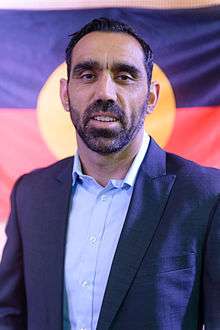Adnyamathanha
 Flag of the Adnyamathanha people | |
 | |
| Total population | |
|---|---|
| Unknown (110 recorded fluent speakers of Adnyamathanha language) | |
| Regions with significant populations | |
| Flinders Ranges | |
| Languages | |
| Adnyamathanha, English (Australian Aboriginal English, Australian English) | |
| Religion | |
| Christianity (Baptist), traditional beliefs |
The Adnyamathanha[1] (Pronounced: /ˈɑːdnjəmʌdənə/) are a contemporary Indigenous Australian people from the Flinders Ranges, South Australia, formed as an aggregate of several distinct peoples. Strictly speaking the ethnonym Adnyamathanha was an alternative name for the Wailpi.[2] Adnyamathanha is also often used as the name of their traditional language, although the language is more commonly called 'yura ngarwala' by Adnyamathanha people themselves (being Adnyamathanha for - loosely translated - 'our speech').
Language
Adnyamathanha is a member of the Thura-Yura language family and the only one which still has fluent native speakers.[3]
Country
On the northern edges of the Adnyamathanha tribal lands were the Diyari tribe, on the western edges were the Kokatha people. To the south were the Barngarla, Nukunu, and Ngadjuri. To the east were the Malyangapa.
Social system
The Adnyamathanha constitute an agglomeration of several peoples, the Kuyani, Wailpi, Yardliyawara, and Pilatapa (amongst others), which are traditional groups of the northern Flinders Ranges and some areas around Lake Torrens. The name Adnyamathanha means "rock people" in the Adnyamathanha language, and is a term referring to the Lakes Culture societies living in that area. They share a common identity, which they get from their ancestors; this common bond is their language and culture which is known as Yura Muda. Adnyamathanha people often refer to themselves as 'yura ', and non-Aboriginal people as 'udnyu '.
Mythology
The origins of the Adnyamathanha are told through creation stories, passed down from generation to generation.[4] The primordial creator figure of the rainbow serpent is, among them, known as akurra.[5]
History of contact
In 1851 the first Europeans settled some of the Adnyamathanha land. This led to many conflicts because the Adnyamathanha people were pushed off their land by the Europeans. In response to the settling, Aborigines stole sheep, which in turn led to retaliatory killings. Aboriginal stockmen and housekeepers soon became a way of life for the early settlers.[4]
Native title
On 30 March 2009, the Adnyamathanha people was recognised by the Federal Court of Australia as having native title rights over about 41,000 square kilometres (16,000 sq mi) running east from the edge of Lake Torrens, through the northern Flinders Ranges, approaching the South Australian border with New South Wales.
In 2016 the Flinders Ranges National Park was renamed the Ikara-Flinders Ranges National Park in recognition of the Adnyamathanha, as 'ikara' is an Adnyamathanha word meaning 'meeting place', which Wilpena Pound (situated within the Park) was and is for the Adnyamathanha people.[6]
Notable people
Adam Goodes, the four-time All-Australian AFL footballer, has declared on his Twitter account, that he is an "Andyamathanha[sic]/Narungga man".[7]
Rebecca Richards, the first Aboriginal Rhodes Scholar, is an Adnyamathanha woman.
See also
Notes
Citations
- ↑ Adnyamathanha.
- ↑ Tindale 1974, p. 219.
- ↑ Clendon 2015, p. 7.
- 1 2 Flinders Ranges National Park 2007.
- ↑ Beckett & Hercus 2009, p. 17.
- ↑ Dulaney, Bennett & Brown 2016.
- ↑ Twitter.
Sources
- "Adam Goodes (@adamroy37)". Twitter. Retrieved 27 January 2015.
- "Adnyamathanha". Aboriginal & Torres Strait Islander Data Archive.
- Austin, Peter (2004). "Diyari (Pama-Nyungan)". In Booij, G. E.; Lehmann, Christian; Mugdan, Joachim. Morphologie: Ein Internationales Handbuch Zur Flexion und Wortbildung. Volume 2. Walter de Gruyter. pp. 1490–1500. ISBN 978-3-110-17278-2.
- Beckett, Jeremy; Hercus, Luise (2009). The Two Rainbow Serpents Travelling: Mura Track Narratives from the 'Corner Country'. Australian National University Press. ISBN 978-1-921-53693-9.
- Clendon, Mark (2015). Clamor Schürmann's Barngarla grammar: A commentary on the first section of A vocabulary of the Parnkalla language. University of Adelaide Press. ISBN 978-1-925-26111-0.
- Dulaney, Michael; Bennett, Tim; Brown, Carmen (1 May 2016). "Flinders Ranges renamed in recognition of traditional Aboriginal owners". ABC News.
- "Flinders Ranges National Park". Cultural Heritage. Department for Environment and Heritage. 2007. Retrieved 17 August 2007.
- Gason, Samuel (1879) [First published 1874]. "The Dieyerie tribe of Australian Aborigines". In Woods, J. D. Native Tribes of South Australia. Adelaide: E. S. Wigg & Son. pp. 253–307.
- Howitt, Alfred William (1904). The native tribes of south-east Australia. Macmillan Publishers.
- Tindale, Norman Barnett (1974). "Wailpi (SA)". Aboriginal Tribes of Australia: Their Terrain, Environmental Controls, Distribution, Limits, and Proper Names. Australian National University Press. ISBN 978-0-708-10741-6.